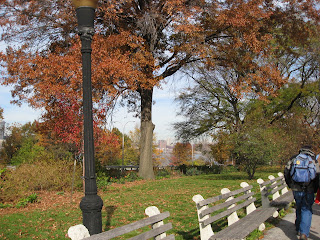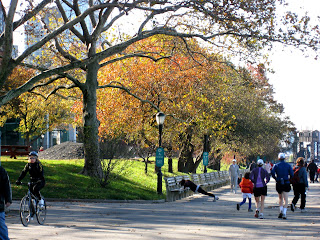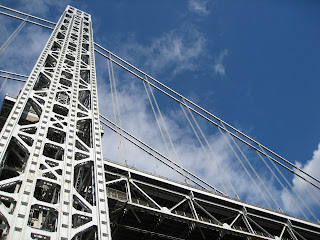Update: November 27, 2011: Did part of below walk again, this time with AMC and added 2 photos of trees pointed out by Fearless Leader, Bob Susser:
Female ginkgo trees have beautiful flowing branches, but watch out for the scent of the fruit! At least this tree has no forbidding, spiky thorns to prevent animals from climbing, as is the case with the honey locust.
We were surprised to learn that there is a giant sequoia right here in NYC!!
Now, back to our original post to take you right up to The Little Red Light House and the G.W. Bridge:
In our quest to
walk 10,000 steps a day, on the second Sunday of November, we joined
Shore Walkers for a New York City Hudson River walk and put 6+ miles/12,000 steps on the old pedometers along Riverside Drive up to the George Washington Bridge

and The Little Red Light House at 181st Street. The leaves were beautiful and we learned a thing or two along the way. We also found a
great map that is down loadable as a pdf in 2 sections (north and south) and marks every single street, playground, dog run, tennis court, athletic field, access and exit, and all points of interest!
This walk can be really helpful for your pedometer walking program. Definitely put us on the trail of better bone density and weight control. Even with our high-calorie lunch and snacks of peanut butter and protein bars, we didn't put on a pound. Hopefully, the next bone-density test will show improvement, too.
For more info, there is a reference list at the bottom of this post.
The landscapes of
Riverside Park were designed by
Frederick Law Olmsted, founder of landscape architecture, and built under the administration of
Robert Moses. The land in Manhattan along the Hudson was originally developed for The
New York Central Railroad. A plan for a
Greenway was made back in the late 1800s. Little by little, walkways are reclaimed from the river and it becomes less frequent that walkers must abandon the shoreline for a few blocks and then rejoin. Hopefully, it will become a continuous path from Battery Park along Hudson River Park connecting to Riverside Park right up to the G.W. Bridge.
We met the group at the West 72nd Street entrance to Riverside Park. Though we have met here before, this was the first time we noticed Eleanor Roosevelt commanding the spot.
The
Riverside Park Promenade was planned to overpass the New York Central Railroad from West 77th to 125th Street. To date, it has been extended south to 58th Street by Donald Trump, and north jointly by Riverside Park Planning Association and NYC up to 155th Street. Walkers, watch out for cyclists. Many speed and most do not yield!
On the promenade at 83rd Street, we learned about
The Warsaw Ghetto Memorial Plaza, a square granite plaque dedicated in 1947. It is one of the first monuments to the Holocaust in the U.S.A. Under it are buried two boxes of soil from
Terezin and
Sered, concentration camps in Czechoslovakia.
And here again, though it was the umpteenth time we walked here, we discovered that this side dirt trail and others like it are called
desire paths because
they are created by people who desire to walk off-trail, or in this case, off-cement.
We liked the softer surface, though one woman insisted that following it was not a very green act because the park supporters worked hard to maintain the grass. No matter that this strip had long ago been given over to walkers.
The many gardens, tended by volunteers, groves of elm trees and other landscape elements were the design of Frederick Law Olmsted. The one at 91st Street was the setting for the romantic last scene in
You've Got Mail.
This building at 107th Street is referred to as
Volunteer House and has an exhibit showing the great planting effort performed in this park by the many planting and clean-up volunteers. It also serves as a meeting house for the Grass Roots Volunteer Program members. There's an open house on some Sundays. Check the link for hours and dates.
This
allee of London Plane trees gives a majestic feel to the park between 101 and 110th Street.
We followed a narrow path around the tennis courts at 119th Street.
We knew we had reached 122nd Street when
Riverside Church peeked up above the tree tops. Not visible from this spot on the path is Grant's Tomb just north of the church. On an earlier AMC walk, we had been surprised to learn that Grant is NOT buried in this tomb. It is a memorial, and not a burial place. So
there to all the posers of the old question....
The first boat dock we came across was back at 79th Street Boat Basin. Above and up here in the 120s at Harlem Piers, there were more, some ruined and some in use.
At 131st Street, you will see the big Fairway Market. Here you have a choice to keep walking on the new bike path, or you can do as we did and temporarily exit the park, cross the street and mount the steps until you reach the gateway to
Riverbank Park built above Riverside Drive.
We walked under the parkway,
and headed for the stone stairs across the street.
At the top, we crossed the bridge and continued around to Riverbank Park with its playing fields,
cafe, facilities, and
picnic tables.
We ate our lunch here and then headed for the steps down.
Before the descent, we took this shot of our goal, the G.W. Bridge and the Little Red Lighthouse.
Down the steps again, we followed the path back to the shoreline.
The Hudson is supposed to be clean enough to swim in, but are the fish in good health?
Warning: When you get to this ballpark, DO NOT try to walk around it on the left. It is life-risking. We did it last May during Shore Walkers' Great Saunter and we are just lucky we got back on safe ground. Walk through the playing fields, even if there's a game going on.
At this point, we all had our jackets off. It was really warm for mid November...
So warm that this poor cherry tree was fooled into blossoming!
But a glance back toward Downtown in afternoon light was a dead giveaway to the coming season.
Pay dirt! Fort Washington Park and The
Little Red Lighthouse
. This spot in the river, called Jeffrey's Hook, was dangerous for river traffic, and in the 1800s, a red pole was constructed to jut out and hold two 10-candle powered lanterns. Then, in 1921, an old dismantled lighthouse was reassembled and put on its spot at Jeffrey's Hook. Just 10 years later, the brighter lights of the new George Washington Bridge made it unnecessary. It was decommissioned by the Coast Guard in 1948.
It became famous as
"The Little Red Light House
" when the children's book,
The Little Red Lighthouse and the Great Gray Bridge, by Swift and Ward

was published.
And of course, we can't leave without a good look up at the
George Washington Bridge, designed by
Othmar Ammann, the bridge that
Mies van der Rohe called "the most beautiful building in New York!"
To exit Fort Washington Park, walk up the ramp just inland from the bridge and follow it up to the crossover.
On the other side, go south (left) to the corner of 181 Street, turn left and enjoy a short walk to Fort Washington Avenue.

There, on the southwest corner, you can take the A train, or ...
... the M4 bus, which works for us because it ends up going down 5th Avenue and we hop off at 72nd Street, not at all far from our hood.
See you next week when we plan to take the reverse direction south along the opposite shore of the Hudson in New Jersey! It's billed as a 14 mile mini-saunter. Better keep clocking those miles.
Or, if walking10 miles up along the Hudson works for your walking program, there is
Shorewalkers' yearly Walk Off the Turkey coming up the day after Thanksgiving.
Olmsted
A Clearing in the Distance:Frederick Law Olmsted
 Frederick law Olmsted:Mogul of ParksFrederick Law Olmsted: Mogul of Parks and Landscaping
Frederick Law Olmsted: Designing the American Landscape
Frederick law Olmsted:Mogul of ParksFrederick Law Olmsted: Mogul of Parks and Landscaping
Frederick Law Olmsted: Designing the American Landscape Robert Moses
The Power Broker:Robert Moses and the Fall of New York
Robert Moses
The Power Broker:Robert Moses and the Fall of New York Robert Moses and the Modern City:The Transformation of New York
Robert Moses and the Modern City:The Transformation of New York
 Rails and Parks
New York Central Railroad:The Big Train
Rails and Parks
New York Central Railroad:The Big Train New York Central Railroad(MBI Railroad Color History)
New York Central Railroad(MBI Railroad Color History)

 Monuments in NYC Parks
Monuments in NYC Parks Walks
Easy Self-Guided Walks in NYC
Walks
Easy Self-Guided Walks in NYC
 NYC Walks; New York Theater Walks
NYC Walks; New York Theater Walks
 Frommer's 24 Great Walks in NY
Frommer's 24 Great Walks in NY

 Walking Manhattan's Rim
Walking Manhattan's Rim
 Paths Along the Hudson: Guide to Walking and Biking
Paths Along the Hudson: Guide to Walking and Biking

 Lighthouses
The Lighthouse Encyclopedia:The Definitive Reference
Lighthouses
The Lighthouse Encyclopedia:The Definitive Reference  Lighthouses:A Pictorial History of Lighthouses
Lighthouses:A Pictorial History of Lighthouses


























































